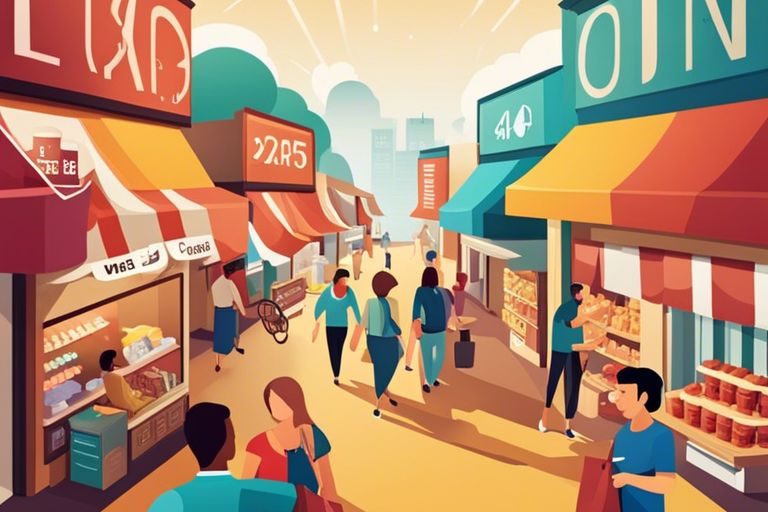Bonus Loyalty Points – Two Way Street

Over the years, loyalty programs have become a staple in the business world, with companies offering various perks to retain customers. One of the most attractive incentives for customers is the opportunity to earn bonus loyalty points. This strategy benefits both the company and the customer, creating a two-way street of rewards and loyalty.
Customers can enjoy extra perks and discounts, while companies can increase customer retention and boost sales. However, it is crucial for customers to carefully consider the terms and conditions, as expired points and restrictions can sometimes make these bonus loyalty points less rewarding than they appear at first glance.
The Psychology Behind Loyalty Programs
Understanding Customer Motivation
While loyalty programs are a popular strategy for businesses to retain customers and encourage repeat purchases, it is crucial to understand the underlying psychology that drives customer participation. For many consumers, the primary motivation to join loyalty programs is the promise of rewards and benefits. This taps into the human desire for instant gratification and the satisfaction of getting more value for their money.
Emotional Connection and Brand Loyalty
While discounts and perks are important components of loyalty programs, the emotional connection between the customer and the brand plays a significant role in sustaining long-term loyalty. The feeling of being valued and appreciated by a brand can create a sense of belonging and strengthen the relationship between the two parties. This emotional bond goes beyond transactional benefits and builds a loyal customer base that is willing to advocate for the brand.
Psychology research has shown that emotional connections with brands can drive purchase decisions even when a cheaper alternative is available. Customers who feel a personal connection with a brand are more likely to overlook minor issues and remain loyal in the face of competition. This highlights the power of emotional branding in cultivating a dedicated customer base.
Designing a Bonus Loyalty Points Program
Setting Goals and Objectives
Some of the key aspects to consider when designing a bonus loyalty points program involve setting clear goals and objectives. These can include increasing customer retention, fostering repeat purchases, and driving customer engagement. Each goal should be specific, measurable, achievable, relevant, and time-bound (SMART) to track the success of the program.
Identifying Target Audiences
Bonus Loyalty Points programs should be tailored to specific target audiences. The identification of these audiences is crucial in determining the type of rewards and incentives that will resonate with them. By segmenting customers based on their preferences, spending habits, and demographics, businesses can create targeted strategies to maximize engagement and loyalty.
The key to a successful loyalty program lies in understanding the needs and preferences of your target audiences. By conducting thorough market research and customer analysis, businesses can create personalized offers that cater to the unique preferences and behaviors of each customer segment.
Structuring Point Accumulation and Redemption
Audiences in a Bonus Loyalty Points program should understand how points are accumulated and redeemed to maximize participation and engagement. By clearly outlining the earning criteria and redemption options, businesses can ensure transparency and encourage customers to actively participate in the program. The structure should be straightforward and easily accessible to avoid confusion and frustration among participants.
The structure of point accumulation and redemption should be designed to incentivize desired customer behaviors and drive profitable actions. Offering flexible redemption options and bonus point promotions can create a sense of exclusivity and urgency among participants, ultimately leading to increased sales and customer loyalty.
Implementing Bonus Loyalty Points Effectively
Integration with Current Marketing Strategies
Bonus loyalty points can be a powerful tool when integrated effectively with your current marketing strategies. By aligning your bonus loyalty points program with your overall marketing objectives, you can enhance customer engagement and drive repeat business. For example, offering bonus points for specific purchasing behaviors or milestones can incentivize customers to make additional purchases and increase their loyalty to your brand.
Utilizing Technology for Program Management
Effectively managing a bonus loyalty points program requires the use of technology to track, monitor, and analyze customer data. By implementing a robust loyalty management platform, you can automate the process of awarding and redeeming bonus points, as well as gain valuable insights into customer behavior and preferences. This data can then be used to optimize your bonus points program and tailor marketing efforts to better meet the needs of your loyal customers.
This approach not only streamlines the management of your loyalty program but also allows you to create a more personalized and seamless experience for your customers. By utilizing technology effectively, you can strengthen customer relationships, increase customer lifetime value, and differentiate your brand from competitors in a highly competitive market.
Benefits for Businesses
Increased Customer Retention
After implementing a bonus loyalty points program, businesses often experience increased customer retention rates. Customers are more likely to return to the same business to accumulate more points and enjoy the rewards. By offering incentives for repeat business, companies can build a sense of loyalty and keep customers coming back for more.
Improved Customer Lifetime Value
Businesses that utilize bonus loyalty points programs can significantly improve their customer lifetime value. By providing rewards for purchases, businesses can incentivize customers to spend more and increase their overall value to the company. This leads to increased revenue and long-term profitability for the business.
For instance, a customer who may have only made a one-time purchase could become a loyal repeat customer through the benefits of a bonus loyalty points program. This not only increases their individual lifetime value but also contributes to the overall success of the business.
Enhanced Data Collection and Analytics
With a bonus loyalty points program in place, businesses can enhance their data collection and analytics capabilities. By tracking customer purchase behavior and preferences, businesses can gain valuable insights into their target market. This data can be used to tailor marketing strategies, improve product offerings, and personalize the customer experience.
Understanding customer behavior and preferences through data collection can help businesses make more informed decisions and drive growth. By analyzing the data gathered through a bonus loyalty points program, businesses can stay ahead of trends, anticipate customer needs, and ultimately increase their competitiveness in the market.
Advantages for Consumers
Perceived Value of Rewards
Consumers participating in loyalty programs benefit from an increased perceived value of rewards. By offering bonus points, discounts, or exclusive offers, businesses can enhance the attractiveness of their rewards program. This not only encourages repeat purchases but also creates a sense of appreciation and recognition among consumers.
Personalization and Exclusivity
The personalization and exclusivity offered through bonus loyalty points can significantly enhance the customer experience. Consumers appreciate tailored rewards and exclusive offers that make them feel valued by the brand. By segmenting customers and offering personalized rewards based on their preferences and behaviors, businesses can strengthen relationships and foster loyalty.
The practice of personalization and exclusivity not only boosts customer retention but also drives engagement and advocacy. By making consumers feel special and appreciated, businesses can create a strong emotional connection that goes beyond transactional interactions.
The Impact on Consumer Behavior
To drive desired consumer behavior, businesses utilize bonus loyalty points strategically. Exclusivity in rewards motivates consumers to engage more with the brand, resulting in increased spending and frequency of purchases. Moreover, the anticipation of earning bonus points can influence consumers' decision-making, leading to a shift in shopping habits and preferences.
This proactive approach to influencing consumer behavior through bonus loyalty points can yield long-term benefits for businesses, fostering a loyal customer base and driving sustainable growth. By tapping into consumer psychology and motivations, businesses can create a win-win scenario where both the brand and consumers reap rewards.
Challenges and Considerations
Avoiding Common Pitfalls
To ensure the success of a bonus loyalty points program, businesses must avoid common pitfalls that can derail their efforts. An important consideration is the clarity of the program's terms and conditions. Providing clear and concise information to customers about how they can earn and redeem points will help prevent confusion and frustration. It is also crucial to set realistic goals and expectations for the program to avoid disappointment among customers.
Maintaining a Sustainable Program
To maintain a sustainable bonus loyalty points program, businesses need to continuously evaluate its performance and make adjustments as needed. One key consideration is monitoring customer engagement and satisfaction levels to ensure that the program remains appealing and valuable to participants. By regularly analyzing data and feedback, businesses can identify areas for improvement and implement changes to enhance the overall program experience.
Businesses should also consider the financial implications of running a bonus loyalty points program to ensure it is cost-effective and sustainable in the long run. By calculating the return on investment and evaluating the program's impact on customer retention and sales, businesses can make informed decisions about the program's future.
Measuring Success and Making Adjustments
Once again, it's time to review the performance of your loyalty points program and make any necessary adjustments. Monitoring the success of your program is crucial to ensuring its effectiveness and relevance in meeting your business goals. By measuring key performance indicators (KPIs) and adapting to market changes and customer feedback, you can maintain a competitive edge and drive customer loyalty.
Key Performance Indicators (KPIs)
With the implementation of a loyalty points program, it is crucial to establish key performance indicators (KPIs) to track the success of the initiative. KPIs such as customer engagement, retention rates, repeat purchase frequency, and overall program participation are crucial metrics to monitor. By analyzing these KPIs, you can assess the impact of your loyalty points strategy and identify areas for improvement or optimization.
Adapting to Market Changes and Customer Feedback
The market is constantly evolving, and customer preferences can change rapidly. It is crucial to stay attuned to market changes and customer feedback to ensure that your loyalty points program remains relevant and effective. Adapting to market changes and addressing customer feedback can help you stay ahead of the competition and meet the evolving needs of your target audience.
Summing up
Hence, it is evident that bonus loyalty points create a symbiotic relationship between customers and businesses. Customers are rewarded for their loyalty and are encouraged to continue patronizing a particular business, while businesses benefit from increased customer retention and higher sales. By understanding the value of bonus loyalty points as a two-way street, businesses can implement effective loyalty programs that foster long-term customer relationships and drive revenue growth.
FAQs
What are bonus loyalty points and how do they benefit customers?
Bonus loyalty points are additional rewards offered to customers for their purchases or other activities. They benefit customers by providing extra perks, discounts, and exclusive offers, enhancing their overall shopping experience and encouraging repeat business.
How can businesses design an effective bonus loyalty points program?
To design an effective bonus loyalty points program, businesses should set clear goals, identify target audiences, structure point accumulation and redemption clearly, and integrate the program with existing marketing strategies. Understanding customer needs and preferences is crucial for tailoring rewards and incentives.
What role does emotional connection play in loyalty programs?
Emotional connection is vital in loyalty programs as it creates a sense of belonging and value for customers. This connection can lead to sustained loyalty, with customers more likely to overlook minor issues and remain committed to the brand even when alternatives are available.
How can technology enhance the management of a loyalty points program?
Technology can streamline the management of loyalty points programs by automating point tracking, awarding, and redemption processes. It also provides valuable insights into customer behavior, enabling businesses to personalize offers and optimize the program for better customer engagement and satisfaction.
What are the key performance indicators (KPIs) for measuring the success of a loyalty points program?
Key performance indicators for measuring the success of a loyalty points program include customer engagement levels, retention rates, repeat purchase frequency, and overall program participation. These metrics help businesses assess the program’s impact and identify areas for improvement.
Recommended Posts

Amelco Boosts Innovation with Flows Technology
October 4, 2024

Win Big with BC.GAME’s $BC Mining Rush Event
October 3, 2024

Stella David Leadership at Entain
October 2, 2024




